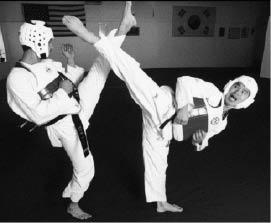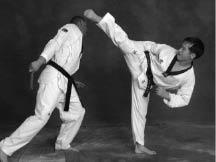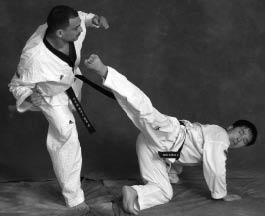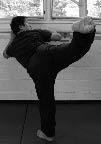Complete Kicking (25 page)
Authors: Turtle Press

applications
The primary target for spin whip kick is the head, which means you should be flexible and fast. Generally, you can kick higher when you kick fast; you can kick fast when you have muscular stability. Through strength and flexibility training, you can attain both. That said, all you need to do is stay alert yet relaxed and look for or make an opportunity of perfect timing. Avoid hitting the torso with spin whip kick to prevent knee and back injuries.
SPORT APPLICATION: Spin whip kick is popular in Taekwondo competition. It is effective as a counterattack when your opponent attacks with an axe kick or roundhouse kick. The best time to counter is when his technique is at its peak. If you fail to do so, strike as his foot lands and his head leans forward.
SPORT APPLICATION: Use spin whip kick to strike the temple as your opponent steps in to attack.
SELF-DEFENSE APPLICATION: After the assailant completes a wide lunging attack, counter with a spin whip kick to the head, meeting force with force.
SELF-DEFENSE APPLICATIONS
A spin whip kick across the back of the knees can be used from the ground to take down an opponent.
If you’ve been knocked down, counter your opponent’s charge with a spin whip kick from the ground.
360 ° BALANCE:
Spin whip kick is one of several advanced kicks that requires a 360° turn of the body. If you have practiced the other turning and spinning kicks in this chapter, you should have developed the foundation skills for a full turn.
To futher perfect your turning, focus on the following:
1. Stand in a neutral fighting stance (weight equally on both legs).
2. Rotate your hip, toros and head in sequence.
3. With the turning momentum let the rear foot “slide” around your body.
4. Repeat #1-3, getting progressively faster. Aim for less than 1/2 second.
target kicking Drills:
Practicing spinning whip kick on a heavy bag or a fixed target can result in a serious knee or back injury. Instead, use a flexible target like a handheld target or speed bag to enhance your accuracy and timing.
Use a hand held kicking target to practice accuracy at different target heights. You can kick at a horizontal, upward or downward angle.
The speed bag resembles a human head, providing realistic feedback when kicked.
ISOTONIC/ISOMETRIC Whip Kick Drill:
Using a combination of isotonic and isometric exercises, you can increase the flexibility, strength and range of motion in your legs and hip.
This combination of isotonic (muscular contraction where the muscle maintains relatively constant tension while the length changes) and isometric (muscular contraction against resistance while the length of the muscle remains the same) training methods is recommended for intermediate and advanced practitioners.
1. Hold the bar with both hands. Shift your weight to the left leg. Raise the right leg to the rear slowly and hold at a 45° angle. Point the toes and stretch the muscles in the front of the leg while tensing the muscles in the right buttock and rear of the leg. Hold for 1 minute.
2. Bring the right leg forward with the toes pointed and the muscles in the front of the thigh tensed while the muscles in the rear of the leg rest. Hold for 1 minute.
3. Raise your right leg to the rear while lowering your torso. Keep the toes pointed and feel the tension in the right buttock and right side of the torso. Rest the muscles in the front of the thigh. Hold for 1 minute.
Other books
Résumé With Monsters by William Browning Spencer
The God Warriors by Sean Liebling
Blue Shoes and Happiness by Alexander McCall Smith
Dante: A Mafia Bad Boy Romance (Sinsations Book 2) by Jessi Talbot
The Riding Master by Alexandrea Weis
Wilderness Courtship by Valerie Hansen
The Delivery by Mara White
Shotgun Charlie by Ralph Compton
Surviving the Pain (A Baby Saved Me Series Book 1) by P. J. Belden
Shadows In Still Water by D.T. LeClaire









